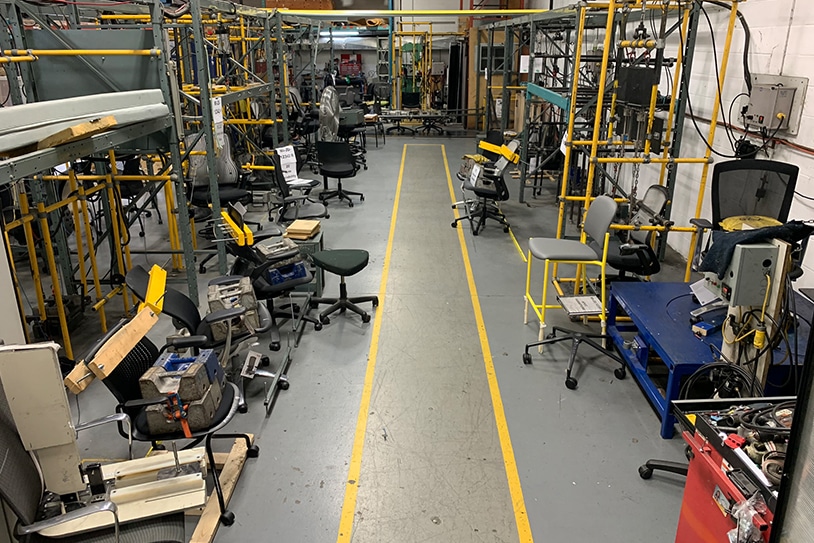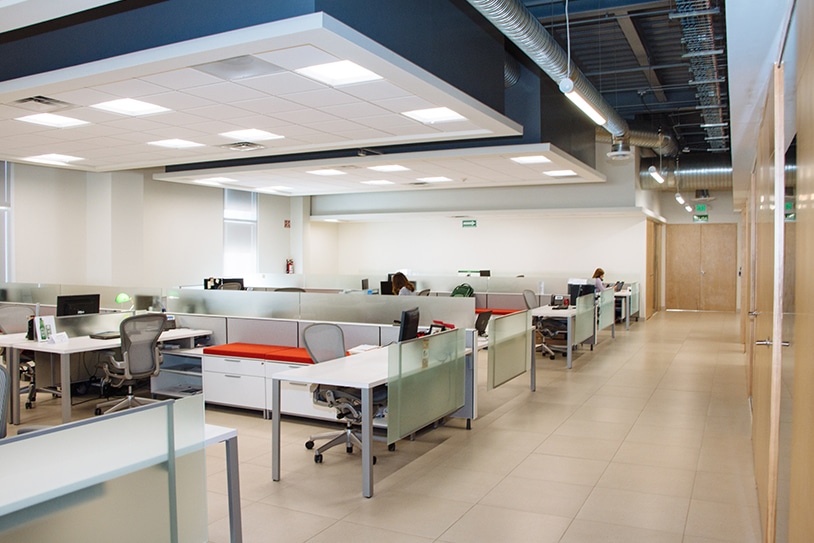
« Association canvas » BIFMA X5.4
BIFMA depuis quelques temps révisait son standard ANSI/BIFMA X5.4-2012 – Lounge and Public Seating – Tests Standard. Le 14 mai dernier BIFMA a publié la nouvelle édition du standard: ANSI/BIFMA X5.4-2020 – Public and Lounge Seating.
Le tableau plus bas est une comparaison test-par-test entre la version 2012 et la nouvelle version du standard. Nous espérons que cette information vous sera utile afin d’évaluer les impacts de la publication de cette nouvelle méthode sur vos produits. Les changements ont été catégorisés comme suit:
- Pas d’impact: pas de nécessité de refaire des essais à terme
- Pas de re-test: Les changements apportés rendent la nouvelle norme plus facile à rencontrer que la précédente version
- Peut exiger un nouvel essai: Selon la configuration mise à l’essai et/ou la méthodologie utilisée par le Laboratoire qui avait fait vos essais précédemment; un nouvel essai est requis.
- Nouvel essai requis: Changement technique significatif dans la méthode nécessitant un nouvel essai
ANSI/BIFMA X5.4 vs « association canvas » comparaison essai-par-essai
| Section # |
Section Title | Comparison | Conclusion |
| – | Title | Title is now “Public and Lounge Seating” instead of “Lounge and Public Seating – Tests” | No impact |
| 1 | Scope | -Scope now includes restaurant/dining/café settings, visitor seating in patient rooms, and folding chairs. -95th percentile male weight increased to 275lb from 253 lbs |
|
|
2
|
Definitions – backrest | Modified definition and included minimum height of 7.9 inch. | No retesting required: New definition narrows scope of applicable features |
| Definitions – folding chair | Added definition | No impact | |
| Definitions – general-purpose large occupant office chairs | Added definition | No impact | |
| Definitions – leg base | Added definition | No impact | |
| Definitions – legrest | Added definition | No impact | |
| Definitions – recliner | Added definition | No impact | |
| Definitions – stool | Added definition | No impact | |
| Definitions – tilt mechanism | Added definition | No impact | |
| Definitions – seat or seating position | When calculating number of seating positions width of seating surface now divided by 28″ (instead of 22.5″) and rounded to the nearest integer (instead of rounded down) | May require retesting: Units that were previously considered single-seaters may now be multi-seaters and vice-versa |
|
| 3.1.3 | General – Testing Considerations | Added statement that if proof loads are held longer than 10 seconds and damage occurs, it is not considered a failure | No retesting required: Clarification is more lenient |
| 3.5 | General – Measurements | Added ISO 24496 CMD as an option | No retesting required: BIFMA CMD still valid |
| 3.6 | General – Tolerances | Added requirement for calibration of devices used to measure test parameters | May require retesting: If your lab’s calibration is not as stringent as new requirements |
| 3.9 | General – Test Environment | Added that sample should be stored in ambient conditions for at least 24 hours before testing. Conditions should be maintained between 15 to 27°C and 10-70% RH and if outside these limits they should be recorded | No retesting required: New limitations are suggestions |
| 3.11 | General – Appendices | Added distinction between Normative and Informative Appendices | May require retesting: See below |
| 5.1 | Backrest Strength Test – Horizontal – Static – Applicability | Added statement that test does not apply to recliners with user force activated back recline mechanisms unless backrest can be locked into position or stops at less than 35 degrees from the vertical. |
No retesting required:
New changes are less critical |
| 5.3.4 | Backrest Strength Test – Horizontal – Static – Test Setup | Limited multi-seat test for units with >2 seats to two adjacent positions. | |
| 5.4.2 | Backrest Strength Test – Horizontal – Static – Proof Load | Proof load now held for 10 seconds instead of 1 minute | |
| 6.3 | Backrest Strength Test – Vertical – Static – Test Setup | Limited multi-seat test for units with >2 seats to two adjacent positions. | No resting required: Units where 3 or more seating positions were previously tested concurrently are worst case |
| 6.4.2 | Backrest Strength Test – Vertical – Static – Proof Load | Proof load now held for 10 seconds instead of 1 minute | No resting required: 1 min proof load more critical than 10 seconds |
| 7.3.4 | Backrest Durability Test – Horizontal – Cyclic – Test Setup | Limited multi-seat test for units with >2 seats to two adjacent positions. |
Retest required:
Increased load on seat makes the test more severe |
| 7.3.6 | Backrest Durability Test – Horizontal – Cyclic – Test Setup | Load on seat increased to 240 lbs from 225 lbs. | |
| 8.3 | Backrest Durability Test – Vertical – Cyclic | Limited multi-seat test for units with >2 seats to two adjacent positions. | No resting required: Units where 3 or more seating positions were previously tested concurrently are worst case |
| 9.4.2 | Arm Strength Test – Horizontal – Static – Proof Load | Proof load now held for 10 seconds instead of 1 minute | No resting required: 1 min proof load more critical than 10 seconds |
| 10.4.2 | Arm Strength Test – Vertical – Static – Proof Load | Proof load now held for 10 seconds instead of 1 minute |
May require retesting:
Units with height-adjustable arms need to be re-evaluated |
| 10.5.2 | Arm Strength Test – Vertical – Static – Acceptance Level | Sudden drop of 1 inch on height-adjustable arms is no longer acceptable during proof loading. | |
| 14.3 | Seating Durability Tests – Cyclic – Test Setup | -Drop height increased to 1.4 from 1.2. -Weight applied on all other seats increased to 240 lbs from 225 lbs. |
Retest required:
Increased drop height and load on seat make the test more severe |
| 14.4 | Seating Durability Tests – Cyclic – Test Procedure | Limited number of identical seating positions to be evaluated (minimum two). | |
| 15.3 | Drop Test – Dynamic – Test Setup | -Added requirement that any center columns not to touch the test platform during functional load. -Added note that casters shall be placed in worst-case position. |
May require retesting:
Units with center columns tested in contact with the ground and/or units with casters not tested in the worst case position require retesting |
| 15.4 | Drop Test – Dynamic – Test Procedures | Limited number of identical seating positions to be evaluated (minimum two) for both functional and proof load. | |
| 16.1 | Leg Strength Test – Front and Side – Applicability | Test is no longer applicable to folding chairs without locking mechanisms. |
No retesting required:
Test scope reduced, allows greater flexibility for testing, proof load now limited and applied for less time |
| 16.3.1 & 16.4.1 | Leg Strength Test – Front and Side – Test Setup | Restraining device may now be used to prevent unit from overturning. | |
| 16.3.2.2 & 16.4.2.2 | Leg Strength Test – Front and Side – Test Procedure – Proof Load | -Proof load now limited to 150 lbf. -Proof load now held for 10 seconds instead of 1 minute |
|
| 17.1 | Unit Drop Test – Dynamic – Applicability | -Test is no longer applicable to units with casters. -Units to be combined with other units to be tested in combined configuration. |
May require retesting: Combined units that were not tested together will require retesting |
| 18.1.3 & 18.2.3 | Caster/Unit Base Durability Test – Cyclic – Test Setup | Load on unit increased to 270 lbs from 250 lbs. | Retesting required: Increased load on unit makes test more severe |
| 19.3 | Swivel Test – Cyclic – Test Setup | -Load on seat increased to 270lbs from 250lbs. -Added clarification regarding “return-to-center” mechanisms. |
Retesting required: Increased load on unit makes test more severe |
| 20.1 | Tilt/rocker/glider Mechanism Test – Cyclic – Applicability | Clarified that test applies to units with rocker or glider mechanisms but not to curved bottom rocking chairs or reclining mechanisms (see new test #25) |
Retesting required:
Increased load on unit makes test more severe |
| 20.3 | Tilt/rocker/glider Mechanism Test – Cyclic – Test Setup | Load on seat increased to 240 lbs from 225 lbs. | |
| 21.1 | Stability Tests – Applicability | -Now only applicable to units with backrests >7.9inch high -Individual segments of ganged units tested individually unless otherwise specified by manufacturer. |
May require retesting: Ganged units that were not tested this way may require retesting |
| 21.3.1 | Rear-Stability for Non-tilting Units – Test Setup | -Added additional guidance for units with casters and rotating units. -Glides now adjusted to midpoint rather than worst case position. -Added additional guidance for disk positioning. -Force now applied 0.25 inch from the top disk instead of 0.24 inch. |
No retesting required: Changes make test less severe |
| 21.4 | Rear-Stability for Tilting Units | Added note to clarify that test is applicable to recliners. | May require retesting: If recliners were not previously tested |
| 21.4.1 | Rear-Stability for Tilting Units – Test Setup | -Glides now adjusted to midpoint rather than worst case position. -Use of new template to locate position of disks on the unit. |
Retesting required:
Changes result in a slightly different test method. |
| 21.4.2 | Rear-Stability for Tilting Units – Test Procedure | Test procedure modified to be more in-line with BIFMA X5.1. | |
| 21.5 | Front Stability for Units <80 lbs | New test procedure for units<80lbs more in-line with BIFMA X5.1. | May require retesting: Units <80 lbs will need to be retested. |
| 21.6 | Front Stability for Units ≥80 lbs | Added note to clarify that test is applicable to units/recliners without legrests or with retracted legrests. |
May require retesting:
If recliners not tested as described |
| 21.6.1 | Front Stability for Units ≥80 lbs – Test Setup | -Glides now adjusted to midpoint rather than worst case position. -Added statement that recliner legrests shall be retracted. |
|
| 21.6.2 | Front Stability for Units ≥80 lbs – Test Procedure | A fixed force of 32 lbf now applied to all units rather than force required to transfer unit weight to front legs. | |
| 22.3 | Tablet Arm Load Ease – Test Setup | -Load decreased to 55 lbs from 77 lbs. -Load application point is now 1 inch from edge instead of tablet center. |
May require retesting: Configuration of the tablet arm may make the new test setup more severe, even with decreased load. |
| 24 | Structural Durability Test – Side-to-Side – Cyclic | New test similar to the one in BIFMA X5.1. | May require retesting: If this test is applicable to the unit it must be done |
| 25 | Cycle Test for Recliners – Backrest and/or Legrest Mechanism Durability | New test. | May require retesting: Recliners need to be tested |
| 26 | Legrest Strength Test – Static Load | New test. | May require retesting: Recliners with integral legrests need to be tested |
| 27 | Footrest Static Load Test for Stools – Vertical | New test. | May require retesting: Stools with legrests need to be tested |
| 28 | Footrest Durability Test for Stools – Vertical – Cyclic | New test. | May require retesting: Stools with legrests need to be tested |
| Appendix A | Impact Test Bag Construction | Sand removed as possible fill media. | May require retesting: If your lab uses sand in their impact bags |
| Appendix B | Stability Disk Construction Details | Added informative text for clarification. | No retesting required: Intent of the Appendix is unchanged |
| Appendix C | Front Stability Load Locator Fixture | New appendix (informative). |
No retesting required:
Informative Appendices |
| Appendix D | Weight Loads/Ratings | New appendix (informative). | |
| Appendix E | Recliner Pinch Point Cautions | New appendix (informative). | |
| Appendix F | Example of a Recliner Cycle Test Fixture | New appendix (informative). | |
| Appendix G | Recliner Front Stability with Legrest Extended | New appendix (informative). | |
| Appendix H | Figure of Leg-Base Chair | New appendix (informative). | |
| Appendix I | Template for Rear Stability | New appendix, Normative | Retesting required: see rear-stability above |
| Appendix J | Summary of Changes | New appendix (informative). |
No retesting required:
Informative Appendices |
| Appendix K | Guidance for Seating Units or Tables with Privacy Screens | New appendix (informative). | |
| Appendix L | Guidance for Seating Flammability | New appendix (informative). | |
| Appendix M | Structural Durability Test – Front-to-Back – Cyclic | New appendix (informative). | |
| Appendix N | Guide for Seating Positions for Non-linear Multiple Seating Units | New appendix (informative). |
Laboratories Micom Inc. est un laboratoire d’essais indépendent accrédité par l’A2LA, l’ONGC, ISTA et de nombreuses autres organisations.
Avertissement
Toutes les informations et opinions contenues dans ce blog sont basées sur l’information et la compréhension que nous avons revues au moment de la publication. Cependant, malgré nos efforts, nous n’offrons aucune garantie quant à leur exactitude, la rigueur de notre enquête ou sa validité. L’auteur de ce blog n’est pas responsable des inexactitudes ou des pertes ou dommages qui pourraient résulter de l’utilisation des informations ou des données contenues dans ce document. Ce blog n’a pas été vérifié pour son exactitude par les associés de groupe de pairs avant la publication.




